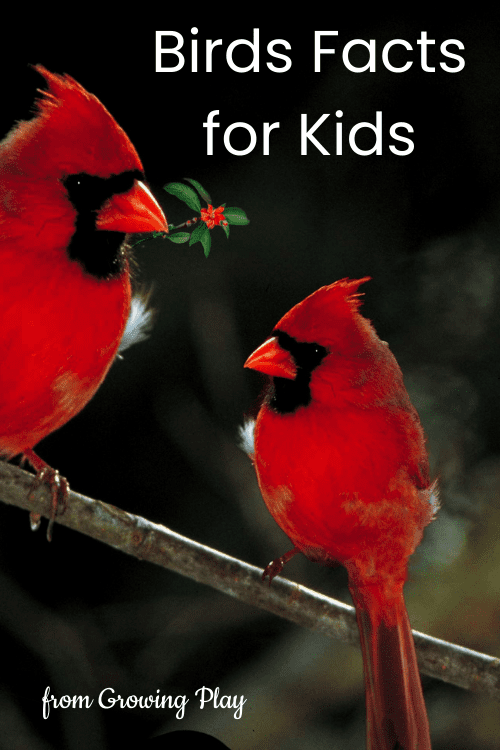Birds Facts for Kids

Grey birds, black birds, white birds, oh my! There are so many different types of birds. From the Bald Eagle to the Arctic Tern, to the Common Raven, and the Great Blue Heron there are many bird species. Can you name any bird species? Keep reading Bird Facts for Kids to learn more bird species and all about the characteristics and appearance of birds.
You can download a FREE printable bird activity packet at the bottom of this post too!

Where in the World are Birds?
Birds are found all over the world, in a wide variety of habitats and climates. Some birds, water birds, live near lakes, rivers, and oceans and often enjoy standing in shallow water. These can include flamingos, herons, and pied geese.
Some birds are highly specialized for certain habitats or environments, while others are very adaptable and can thrive in a variety of conditions.
Birds that prefer warmer weather often migrate great distances in huge flocks towards the sun. This is a behavior known as bird migration. Birds use many different cues to determine when they should start migrating, including weather patterns, changes in light levels, and the position of the sun in the sky. That means birds may live in the northern hemisphere for half a year and then migrate to the southern hemisphere for the rest of the year. I wish I could do that too! Who’s with me?

Bird Cryptogram for Kids
Birds Facts for Kids – Birds in Flight
Birds have hollow bones that reduce their weight and allow them to fly more easily. Different birds fly at different speeds and some rely on the use of long streams of air to push them forward.
The fastest birds are the peregrine falcons, which can reach speeds of up to 200 miles per hour (320 km/h) when diving after its prey.
The highest flying bird is the Ruppell’s vulture, which has been recorded soaring up to a high place of over 37,000 feet (11.3 km) in the air!
Some birds are actually flightless birds, meaning they can’t fly. These include the Kiwi Birds, which are native to New Zealand.
Characteristics of Birds
There are tens of thousands of different species of birds, ranging from small birds like hummingbirds to large birds like ostriches and emus.
Many birds are excellent singers, and their songs are often used to attract mates or warn off other birds from their territory. Some people say bird songs sound just like human songs. Do you agree with that?
Birds are among the most intelligent animals on Earth, with some species rivaling primates in intelligence and reasoning ability. Are you smarter than a bird?

Can you Sense That? – All About Bird Senses
Birds have a keen sense of hearing and eyesight, which helps them find food and avoid predators. Some birds also have an interesting ability called “sixth sense,” which allows them to sense magnetic fields and navigate using the Earth’s magnetic poles.
Most birds have excellent vision compared to other animals, with some birds even able to see ultraviolet light invisible to humans. They also have a nictitating membrane – a clear, protective “third eyelid” that closes sideways across the eye to keep it moist and protected.
While birds have a highly developed sense of smell, they lack the ability to taste sweetness. Birds can easily find flowers for nectar, but they likely can’t even taste it.
Birds are very vocal animals, with many different species capable of producing a wide variety of sounds using their syrinx (bird vocal organ). Birdsong is often used to communicate mate selection, territorial boundaries, and warnings of predators.

Animal Care Pretend Play Packet
Birds Facts for Kids – Bird Feathers
Many birds are well-known for their beautiful plumage – the bright colors and intricate patterns on their feathers. What is your favorite color bird?
Birds are known for having such beautiful feathers and vibrant plumage, which is typically used to attract mates or scare off predators. Feather color is determined by pigments like melanin and carotenoids found in the birds’ diet and environment.
Birds can sometimes lose primary feathers after an injury, which can affect the way they fly – although in some cases birds will actually “re-grow” new primary feathers faster than their old ones fall out!
Diet and Eating
Most birds are omnivorous, feeding on a variety of foods, both plants and animals, depending on what’s available in their environment. Some birds are specialized for eating only insects or flower nectar, while others feed exclusively on fish or small mammals like mice and rats. Some birds, like vultures and the turkey vulture, will eat dead animals. Ew!
Although birds are vertebrates (animals with a backbone), they don’t have teeth – instead, they have beaks! The shape of the beak is often adapted for its specific diet; for example, birds that eat insects usually have long, thin beaks that help them catch their prey, while birds that eat seeds or nuts usually have short, sturdy beaks that help them crack open hard shells.
Birds Facts for Kids – Bird Adaptations
Whether they’re soaring high in the sky or hopping around on the ground, birds have unique adaptations that help them move and feed effectively in their environment. For example, some birds have long, powerful legs for running and jumping, while others have short legs and wings that help them maneuver quickly in trees.
Birds are warm-blooded animals, meaning they can maintain a consistent body temperature regardless of the surrounding temperature.

The Size of Birds
The largest living bird is the African ostrich, which can weigh up to 350 pounds (160 kg) and stand up to 9 feet (2.7 m) tall.
The smallest bird is the bee hummingbird, which weighs less than 1/10 of an ounce (2.8 g) and is just 2.4 inches (6 cm) long. This species of bird has especially small wings.
Birds Facts for Kids – Reproduction and Mating
Birds typically mate for life, although some species do practice “divorce” if they’re unable to find a suitable mate or if conditions are unfavorable for raising young. To find a mate, birds often use mating calls and the female birds of many species may ruffle their feathers or adjust their appearance to attract a mate.
Most birds lay eggs, which are incubated by the parents until they hatch. The newly hatched chicks are typically helpless and depend on their parents for food and shelter.
Bird Lifespans
Birds typically live 10-15 years in the wild, but some species can live much longer – up to 50 years or more!
When birds die, they decay into skeletons which can become fossils over time. The oldest known bird fossil is from the Late Jurassic period, around 150 million years ago.
Birds Facts for Kids – The Importance of Birds
Birds play an important role in the ecosystem by pollinating flowers, dispersing seeds, and controlling insect populations.
Birds are a popular subject of study in fields like ecology, evolution, and behavior. Many people also enjoy bird watching or birding. This is a popular hobby all over the world, with people of all ages enjoying the beauty and diversity of birds in their natural habitats. Would you ever want to try bird watching? Let us know and make sure you take lots of pictures of everything you see!
DOWNLOAD MY FREE BIRDS FACTS FOR KIDS ACTIVITY PACK
Sign up to receive the Growing Play email newsletter. If you already subscribe enter your email below – you will not be subscribed twice.

WANT MORE FUN FACTS FOR KIDS?
Check out these fun facts for kids here and browse all the other topics at the bottom of the post.


